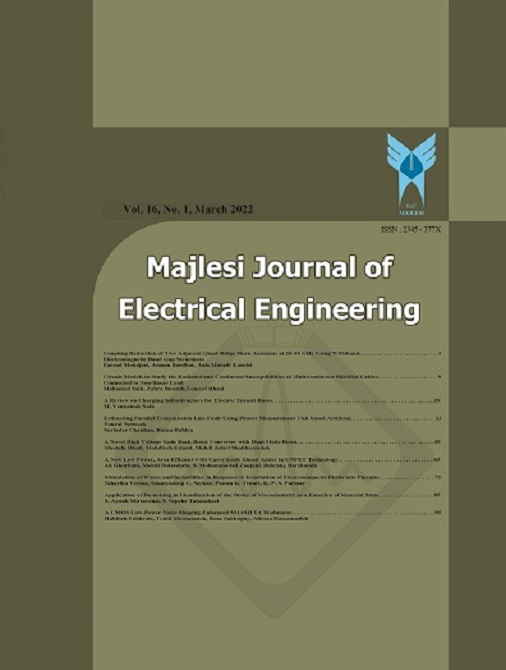[1] Ran-Zan Wang, Chi-Fang Lin, Ja-Chen Lin, Hiding data in images by optimal moderately signicant-bit replacement, IEE Electron. Lett. 36 (25) (2000) 2069–2070. https://doi.org/10.1049/el:20001429
[2] J. Fridrich, R. Du,and M. Long, “Steganalysis of LSB encoding in color images,” in Proc. ICME 2000, New York, NY, USA, 31 July–2 August 2000. https://doi.org/10.1109/ICME.2000.871000
[3] J. Fridrich, M. Goljan, and R. Du, “Reliable detection of LSB steganography in grayscale and color images,” in Proc. ACM Workshop on Multimedia and Security, pp. 27–30, Ottawa, Canada, October 2001. https://doi.org/10.1145/1232454.1232466
[4] J. Fridrich, M. Goljan, and R. Du, "Invertible Authentication, " Proc. SPIE Security and Watermarking of Multimedia Contents, San Jose, CA, Jan. 2001, 197-208. https://doi.org/10.1117/12.435400
[5] J. Fridrich, M. Goljan, and R. Du, “Lossless data embedding- new paradigm in digital watermarking,” EURASIP J. Appl. Signal Processing, vol. 2002, no. 2, pp. 185–196, Feb. 2002. https://doi.org/10.1155/S1110865702000537
[6] C.D. Vleeschouwer, J.F. Delaigle, and B. Macq, "Circular Interpretation of Bijective Transformations in Lossless Watermarking for Media Asset Management," IEEE Trans. Multimedia, 5(3) (2003) 97-105. https://doi.org/10.1109/TMM.2003.809729
[7] Chan CK, Cheng LM. Hiding data in images by simple LSB substitution. Pattern Recognition 2004;37(3):469–74. https://doi.org/10.1016/j.patcog.2003.08.007
[8] Wu HC, Wu NI, Tsai CS, Hwang MS. Image steganographic scheme based on pixel-value differencing and LSB replacement methods. IEE Proceedings: Vision, Image & Signal Processing 2005;152(5):611–5. https://doi.org/10.1049/ip-vis:20059022
[9] Celik MU, Sharma G, Tekalp AM, Saber E (2005) Lossless generalized-LSB data embedding. IEEE Trans Image Process 14(2):253–266. https://doi.org/10.1109/TIP.2004.840686
[10] Zhang X, Wang S. Efficient steganographic embedding by exploiting modification direction. IEEE Communication Letters 2006;10(11):781–3. https://doi.org/10.1109/LCOMM.2006.060863
[11] M.U. Celik, G. Sharma, E. Saber, and A.M. Tekalp, "Lossless Watermarking for Image Authentication: A new Framework and an Implementation," IEEE Trans. Image Processing. 15(4) (2006) 1042- 1049. https://doi.org/10.1109/TIP.2005.863053
[12] Jun Tian, “Reversible Data Embedding Using a Difference Expansion,” IEEE Trans. Circuits Syst. Video Technol, vol. 13, no. 8, pp. 890-896, Aug. 2003. https://doi.org/10.1109/TCSVT.2003.815962
[13] Alattar AM. Reversible watermark using the difference expansion of a generalized integer transform. IEEE Transactions on Image Processing 2004;13(8):1147–56. https://doi.org/10.1109/TIP.2004.828418
[14] Thodi DM, Rodriguez JJ. Expansion embedding techniques for reversible watermarking. IEEE Transactions on Image Processing 2007;16(3):721–30. https://doi.org/10.1109/TIP.2006.891046
[15] Chin-Chen Chang, Ying-Hsuan Huang, Hsin-Yi Tsai, Chuan Qin . Prediction-based reversible data hiding using the difference of neighboring pixels. Int. J. Electron. Commun. (AEÜ) 66 (2012) 758– 766. https://doi.org/10.1016/j.aeue.2012.01.008
[16] Qin C, Chang CC, Liao LT (2012) An adaptive prediction-error expansion oriented reversible data hiding scheme. Pattern Recogn Lett 33(16):2166–2172. https://doi.org/10.1016/j.patrec.2012.08.004
[17] Qu X, Kim S, Kim HJ (2015) Reversible watermarking based on compensation. J Electr Eng Technol 10(1):422–428. https://doi.org/10.5370/JEET.2015.10.1.422
[18] Chang, C., Huang, Y. & Lu, T. A difference expansion based reversible data hiding scheme with high stego image visual quality. Multimed Tools Appl 76, 12659–12681 (2017). https://doi.org/10.1007/s11042-016-3689-3
[19 ] Ni, Z., Shi, Y.Q., Ansari, N., Su, W.: Reversible Data Hiding. IEEE Transactions on Circuits and Systems for Video Technology 16(3), 354–362 (2006). https://doi.org/10.1109/TCSVT.2006.869964
[20] Fallahpour M, Sedaaghi MH (2007) High capacity lossless data hiding based on histogram modification. IEICE Electron Express 4(7):205–210. https://doi.org/10.1587/elex.4.205
[21] Hong W, Chen TS, Shiu CW (2008) Reversible data hiding based on histogram shifting of prediction errors. Proceedings of the International Symposium on Intelligent Information Technology Application Workshop 00 292–295. https://doi.org/10.1109/ETTandGRS.2008.263
[22] Hong W, Chen TS, Shiu CW (2009) Reversible data hiding for high quality images using modification of prediction errors. J Syst Softw 82(11):1833–1842. https://doi.org/10.1016/j.jss.2009.05.051
[23] Tsai PY, Hu YC, Yeh HL (2009) Reversible image hiding scheme using predictive coding and histogram shifting. Signal Process 89(6):1129–1143. https://doi.org/10.1016/j.sigpro.2008.12.017
[24] M. Fallahpour, D. Megias, M. Ghanbari, Subjectively adapted high capacity lossless image data hiding based on prediction errors, Multimedia Tools and Applications, Springer, 2010. https://doi.org/10.1007/s11042-010-0486-2
[25] Z. Pan, S. Hu, X. Ma, L. Wang, Reversible data hiding based on local histogram shifting with multilayer embedding, J. Vis. Commun. Image Represent 31 (2015) 64–74. https://doi.org/10.1016/j.jvcir.2015.05.005
[26] Hu YC, Tsai PY, Yeh JS, Chen WL (2015) Residual histogram shifting technique based on cascading prediction for reversible data hiding. Advanced multimedia and ubiquitous engineering, Berlin, Heidelberg, 2015, pp. 105–110. https://doi.org/10.1007/978-3-662-47487-7_16
[27] He W, Xiong G, Zhou K, Cai J (2016) Reversible data hiding based on multilevel histogram modification and pixel value grouping. J Vis Commun Image Represent 40:459–469. https://doi.org/10.1016/j.jvcir.2016.07.014
[28] Yu C, Zhang X, Tang Z, Xie X (2018) Separable and error-free reversible data hiding in encrypted image based on two-layer pixel errors. IEEE Access 6:76956–76969. https://doi.org/10.1109/ACCESS.2018.2882563
[29] Tang Z, Xu S, Ye D, Wang J, Zhang X, Yu C (2019) Real-time reversible data hiding with shifting block histogram of pixel differences in encrypted image. J Real-Time Image Proc 16(3):709–724. https://doi.org/10.1007/s11554-018-0838-0
[30] X.-Z. Xie, C.-C. Chang, and Y.-C. Hu, ‘‘An adaptive reversible data hiding scheme based on prediction error histogram shifting by exploiting signed-digit representation,’’ Multimedia Tools Appl., vol. 79, nos. 33–34, pp. 24329–24346, Sep. 2020. https://doi.org/10.1007/s11042-019-08402-6
[31] L. Zhang and X. Wu, “An edge-guided image interpolation algorithm via directional filtering and data fusion,” IEEE Trans. Image Process., vol. 15, no. 8, pp. 2226–2238, Aug. 2006. https://doi.org/10.1109/TIP.2006.877407
[32] K.H. Jung and K.Y. Yoo, Data hiding method using image interpolation, Computer Standards and Interfaces, 31(2)(2009) 465-470. https://doi.org/10.1016/j.csi.2008.06.001
[33] L. Luo, Z. Chen, M. Chen, X. Zeng, and Z. Xiong, “Reversible image watermarking using interpolation technique,” IEEE Trans. Inf. Forensics Secur., vol. 5, no. 1, pp. 187–193, 2010. https://doi.org/10.1109/TIFS.2009.2035975
[34] M.A.M. Abadi, H. Danyali, M.S. Helfroush, Reversible watermarking based on interpolation error histogram shifting, In: 5th International Symposium On Telecommunications (IST), Kish Island, Iran, 2010, pp. 840–845. https://doi.org/10.1109/ISTEL.2010.5734139
[35] Ye, Hanmin, Zhibo Li, and Lili Pu. "Research on Reversible Date Hiding Algorithms Based on Bilinear Interpolation about Watermark." In Proceedings of the 2020 3rd International Conference on E-Business, Information Management and Computer Science, pp. 592-596. 2020. https://doi.org/10.1145/3453187.3453400
[36] Standard dataset images available at https://ccia.ugr.es/cvg/CG/base.htm
[37] The USC-SIPI Image Database https://sipi.usc.edu/database/

